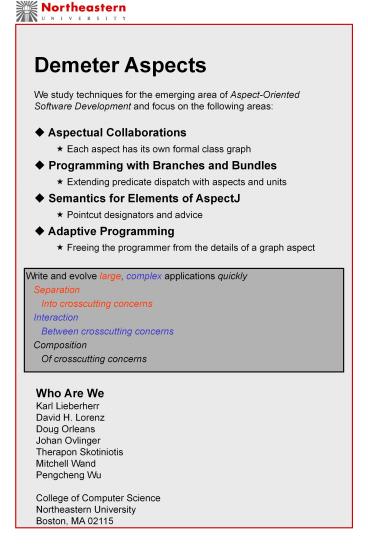NUPO Conference - PowerPoint PPT Presentation
Title:
NUPO Conference
Description:
collaborations work is that they basically add around methods to. achieve aspectual capability. ... modularizing cross-cutting concerns, we are building up a set of ... – PowerPoint PPT presentation
Number of Views:23
Avg rating:3.0/5.0
Title: NUPO Conference
1
- Demeter Aspects
- We study techniques for the emerging area of
Aspect-Oriented Software Development and focus on
the following areas - Aspectual Collaborations
- Each aspect has its own formal class graph
- Programming with Branches and Bundles
- Extending predicate dispatch with aspects and
units - Semantics for Elements of AspectJ
- Pointcut designators and advice
- Adaptive Programming
- Freeing the programmer from the details of a
graph aspect
Write and evolve large, complex applications
quickly Separation Into crosscutting
concerns Interaction Between crosscutting
concerns Composition Of crosscutting concerns
Who Are We Karl Lieberherr David H. Lorenz Doug
Orleans Johan Ovlinger Therapon
Skotiniotis Mitchell Wand Pengcheng Wu College
of Computer Science Northeastern
University Boston, MA 02115
2
Aspectual Collaborations Aspectual
Collaborations (AC) capture both structural and
behavioral concerns in a single unit. AC are
modular building blocks that can be composed to
construct AC with complex sharing between the
constituent collaborations. Composition is used
to attach aspectual methods, provide deferred
features, and control the interface of the
resulting collaboration. Collaborations with
differing structural assumptions can be composed
by reconciling any differences in the composition
declaration, greatly increasing the scope for
reuse of concerns. AC have been implemented on
top of AspectJ, and a separate byte
code-rewriting implementation is underway. We
apply AC to both real-time embedded applications
with BBN and banking applications with UBS.
Supported by the National Science Foundation
(NSF) under Grant No. CCR-0098643.
3
- Branches and Bundles
- Incremental Programming (branch is basic building
block) - Branch has a
- condition expressed in terms of a decision point
and - body
- Decision point message send
- Program collection of branches organized into
bundles. - Each bundle describes one concern.
- Branch condition may involve
- run-time type and state of arguments,
- message, enclosing branch, global properties.
- A branch is fundamentally different than a
procedure or a method - Describes in detail the conditions under which it
will be applied. A procedure has no control over
when it will be applied and a method has a little
control. - Predicate dispatching uses an arbitrary predicate
expression over the message arguments to specify
when a method is executed. By making the "when
to execute" part of a behavioral unit definition
more flexible, we can better separate behavioral
concerns that would otherwise need to be tangled
together in an explicit dispatch expression. - We are developing an extension to predicate
dispatching that can lead to separation of
cross-cutting behavioral concerns, by allowing
methods to specify that they modify other methods
(around methods),
4
Formal Semantics for AOP In order to better
understand and precisely specify the mechanisms
for modularizing cross-cutting concerns, we are
building up a set of formal semantics for
aspect-oriented programming. We have
started with a denotational semantics for the
basic building blocks of dynamic join points and
advice as embodied by AspectJ, using a variant
of store-passing monads to model computations and
modeling advice as procedure transformers. Our
goal is to develop a theory of AOP that accounts
for other models such as Demeter and HyperJ.The
second stage of the project was to design a
system that would satisfy the specifications.
Adaptive Programming Adaptive Programming
(AP) is a technology that helps to disentangle
the structural concern from the behavioral
concerns by allowing traversals of composite
objects to be specified in a structure-shy way,
as traversal strategies. We actively use
and improve this technology in the form of DJ, a
pure-Java package for constructing traversal
strategies dynamically the AP library,
a pure-Java package for parsing and expanding
traversal strategies and DemeterJ, which
generates static traversal code from input in the
form of Java code extended with traversal
strategies. Recently, we developed a simplified,
object based semantics for AP. E-mail
dem_at_ccs.neu.edu http//www.ccs.neu.edu/research/d
emeter
Supported by DARPA under agreement
F33615-00-C-1694 and NSF under grant
CCR-0098643.






























